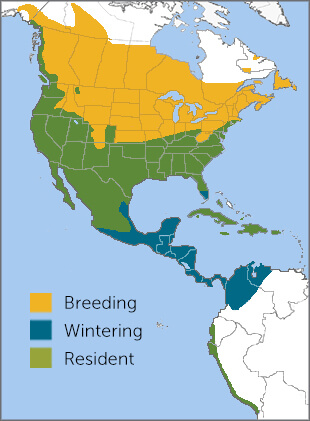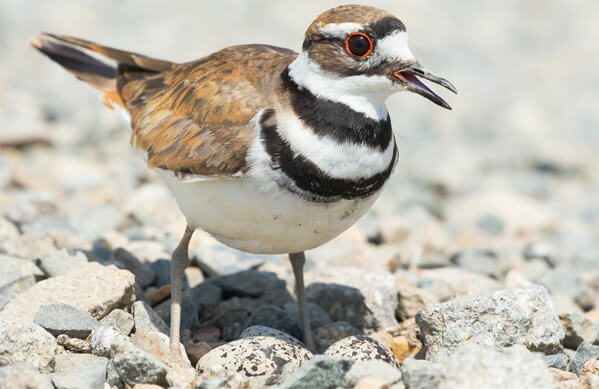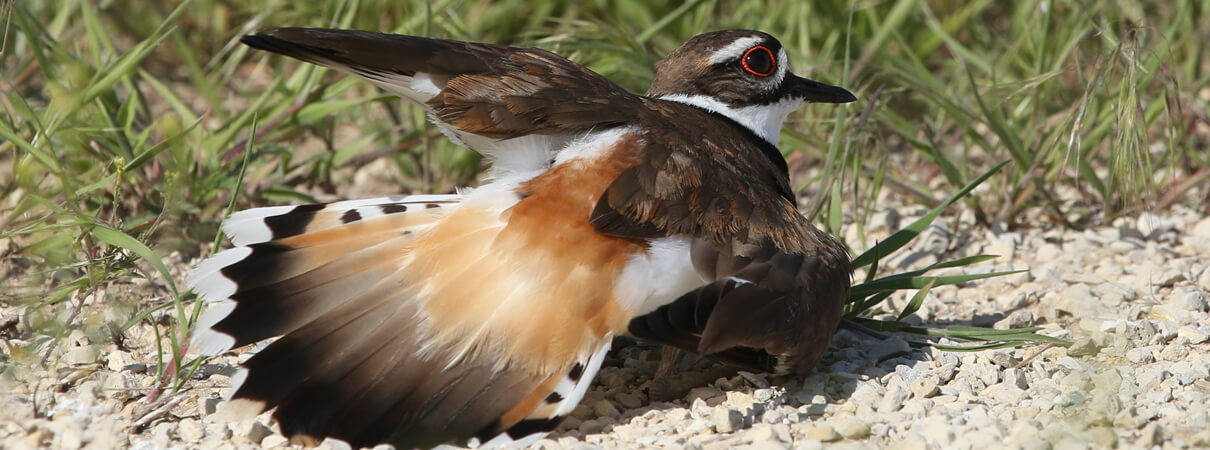
Killdeer range map by American Bird Conservancy
The Killdeer is the largest and most familiar of the "ringed" plovers, a group that includes the Piping and Wilson's Plovers. Although classified as a shorebird, this conspicuous, double-banded species is most often found in areas far from water — similar to other shorebirds such as the Mountain Plover or Long-billed Curlew.
Across most of North America, the Killdeer is a familiar species, thanks to its presence in open habitats and its loud calls, which give it both its common and scientific species names — “Killdeer” and “vociferus” (from the Latin for “shouting” or “yelling”). Scroll down to hear the calls.
Named for a Noise
Naming something, like a Killdeer, for its sound uses a convention known by the Greek name “onomatopoeia,” literally “imitation of a sound.” Several members of the nightjar family, including the Eastern Whip-poor-will, Chuck-will's-widow, and Common Poorwill, are named for the sound of their loud, repetitious nocturnal songs.
The Northern Bobwhite declares its name with a ringing "bobWHITE"! The Black-capped Chickadee also seems to sing its name, and the boisterous flycatcher known in English as the Great Kiskadee has onomatopoeic names in other languages as well — “Cristo fue” (Spanish), “Kitaukah” (Miskito), and “Bem-te-vi” (Portuguese).
In earlier times, the Killdeer was also known as the Chattering Plover or the Noisy Plover, both nods to its vocal nature. Killdeer often call in flight and at night. When disturbed, they give a prolonged chattering call and are often the first birds to sound an alarm if a predator or other threat approaches. Listen here:
Kill-dee(r) call — used for alert, display, or in flight:
(Audio of Killdeer by Paul Marvin, XC169203. Accessible at www.xeno-canto.org/169203.)
Alarm call:
(Audio of Killdeer by Manuel Grosselet, XC253361. Accessible at www.xeno-canto.org/253361.)
Leapfrog Migrant
Most shorebird species, such as the Red Knot, are champion long-distance migrants, but depending upon the population, the Killdeer can be a year-round resident or a partial, or "leapfrog," migrant. Killdeer in the northern United States and Canada migrate south each year to escape harsh winter weather, passing right over regions such as the southern U.S. where other Killdeer populations are nonmigratory.
The Killdeer is the most widespread North American plover species. The breeding range extends from central Alaska east to Newfoundland and down. Killdeer occur year-round along much of the Pacific Coast, lower elevations of the Rockies, and across the southern United States, then well into Mexico. Wintering birds are found south to northern South America.
Killdeer are found year-round in the Caribbean, and there is a separate permanent population in coastal Ecuador and Peru, too.
Dashing and Dining
The Killdeer feeds on invertebrates such as earthworms, beetles, grasshoppers, and snails, sometimes adding seeds and small vertebrates to its diet. This plover forages on the ground in a characteristic manner: dashing a short distance, stopping to seize prey, then running onward in search of the next tidbit. Killdeer will also pat the ground with one foot to stir up prey, or probe mud like a Semipalmated Sandpiper. They even follow tractors, in search of prey turned up by the plow.
Dual Displays
Killdeer couples perform both aerial and ground displays as a duo. During flight displays, both birds hover high in the air or make short, butterfly-like flights on stiff wings with slow wingbeats, calling all the while. On the ground, the pair displays to each other by bowing with fanned tails, revealing their bright orange-brown rumps and uppertail feathers.
Killdeer usually nest in open areas with sparse vegetation or on a gravel surface. In developed areas, parking lots and rooftops are favored nest sites. Both the male and female participate in building the nest, a simple scrape or shallow depression in the ground. The pair lines the nest with small rocks, shells, or other objects. Killdeer nests are always well-camouflaged, and the four heavily speckled eggs blend perfectly with their surroundings. Both the male and female take turns incubating the clutch.
Like many other shorebirds, such as the Wilson's Snipe and Snowy Plover, the Killdeer performs a "broken wing" distraction display to lead predators away from its nest. To guard against large hoofed animals that may mistakenly trample its nest, the Killdeer uses a different display, fluffing itself up, fanning its tail over its head, and running at the intruder to change its path.
Killdeer chicks hatch with eyes open and covered in downy fluff; they leave the nest almost immediately, attended by their parents. Young Killdeer only have one breast band, and can easily be mistaken for smaller plover species.
Familiarity Breeds Threats
Since the Killdeer adapts well to human habitats, it remains a common and widespread species in many areas. This proximity carries some risks, though. Pesticide poisoning poses a major threat, since Killdeer forage on lawns and other open spaces that are often sprayed with toxins. Although DDT has been banned in the United States, other toxic chemicals are still in use, such as neonicotinoids, chlorpyrifos, and glyphosate (used in a familiar and widely advertised weed-killer now the target of many lawsuits). Pesticides can also affect insect populations, the chief food source for this bird.
Killdeer are also vulnerable to collisions with towers, buildings, and cars, since nesting birds are attracted to the gravel surrounding building pads and along road shoulders. In addition, mowing equipment can damage nests and kill or injure young, as well as disturbing breeding birds. In mowed areas, locating nests first and marking the area as a temporary “no-mow” zone is essential for individual nest success.
Many of ABC's policy programs help to reduce the impacts of these hazards. We're fighting to block or restrict dangerous pesticides in homes, gardens, and in agriculture. We work with manufacturers to develop bird-safe glass, and recommend changes to powerlines, towers, and other structures to minimize impacts on migrating birds. We also advocate for stronger local, state, and federal regulations to protect birds and other wildlife from these threats.
Donate to support ABC's conservation mission!




















































